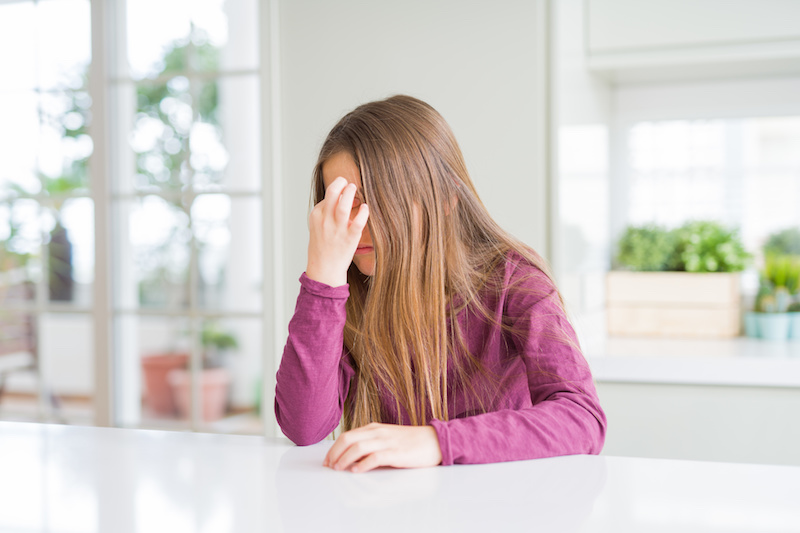Chronic headaches: Five things families should know

You might think of headaches as an adult problem, but they can affect children and teens, too. In fact, about 20 percent of school-aged kids are prone to headaches, according to the National Headache Foundation. A smaller number of those kids experience chronic headaches, which are defined as headaches that occur 15 or more days a month. Just as chronic headaches can cause disability and sick days in grownups, they can have serious effects on children’s lives, leading them to miss school, extracurricular activities, and social events.
For kids with chronic headaches, well-rounded care is key, says Dr. Alyssa Lebel, director of the Chronic Headache Program at Boston Children’s Hospital. “Kids are resilient and respond well to approaches such as exercise and relaxation techniques,” she explains. “Our goal is to intervene early, so chronic headaches don’t turn into a lifetime of chronic pain.” She recommends that parents consider seeking specialized care if their child experiences chronic headaches that haven’t readily responded to medication and wellness interventions and that interfere with daily activities, especially exercise and school.
Here are five more things that every family should know about chronic headaches in kids.
1. Not all headaches are migraines.
The word “migraine” is often used to describe any bad headache, but that’s not always the case. Indeed, only about 5 percent of kids with chronic headaches are diagnosed with migraines. The rest have recurrent head pain caused by a wide range of factors, ranging from tension to neurosurgical procedures. What’s more, kids with true migraines can have very different symptoms than adults, including dizziness and abdominal discomfort. Bottom line: Only a clinician can determine the type of headache your child has.
2. Kids don’t always outgrow headaches.
Although some research suggests that children with chronic daily headaches may see the condition ebb as they get older, that’s not true for everyone. Headaches can change over time and are influenced by many factors, including hormones. “It’s not unusual for chronic headaches to worsen during puberty,” explains Dr. Lebel. That’s one more reason why kids with chronic headaches can benefit from early and ongoing care — you shouldn’t assume the problem will just go away with time.
3. Adult treatments aren’t always right for kids.
Families tend to get excited about new approaches to chronic headaches, but these treatments may not be appropriate for children, whose brains are still developing. “We have to be careful not to quickly turn to the newest or latest treatment, whether that’s a medication or CBD oil,” says Dr. Lebel. “For most of these therapies, we just don’t have the data on their use in kids yet.”
4. A wellness approach is best.
The clinicians in the Chronic Multidisciplinary Headache Clinic take a wholistic approach to care that takes many different aspects of a child’s and family’s health into account. That includes explaining what chronic headaches are and taking an extremely detailed patient history, gathering information about sleep, diet, and sources of stress.
It also includes a psychological evaluation — especially important because many kids with chronic headaches appear to have anxiety or a lower stress threshold. “We’re not saying that the pain is all in their head,” explains Dr. Lebel. “Chronic headache is a primary disorder of the brain, so we need to use the brain to help fix it.”
That means working with families to make healthy lifestyle changes, including improving sleep and nutrition, getting regular physical activity, and learning relaxation techniques and other coping strategies. Multidisciplinary care for chronic headaches can also involve treating associated disabilities and comorbidities that can occur with chronic pain, such as anxiety and depression. When appropriate, Dr. Lebel and her colleagues offer adjunct therapies like medication, injections, and infusions to help temporarily relieve headache pain.
5. Treatment takes time.
Unfortunately, there’s no quick fix for chronic headaches in kids. A multidisciplinary approach can be extremely beneficial, but it won’t eliminate head pain overnight. Families can expect lot of education, conversations with clinicians, and even homework, such as assignments to safely incorporate exercise and tips for managing stress. Follow-up appointments occur over months and even years.
“Some parents view our clinic as the end of the road, when nothing else has worked,” says Dr. Lebel. But the truth is that treatment occurs on a continuum and can require patience. It helps to look on the bright side. “We try not to focus on the amount of pain a child is feeling, but on what they can do as they start to improve: How many more days could they go to school? Are they able to return to ballet class? Have they been hanging out with their friends more?” explains Dr. Lebel. “Kids get distracted by positive experiences — we want parents to understand that, too.”
Learn about the Chronic Headache Program.
Related Posts :
-

Which pain medication is right for your child? What a pediatrician wants parents to know
There’s no shortage of safe and effective pain medications for children. Acetaminophen (commonly known as Tylenol), ibuprofen (Motrin, Advil), ...
-

Full-family support sees Hannah and her parents through AVM surgery
Nine-year-old Hannah from Vermont is passionate about skiing; not much keeps her off the slopes. In fact, not much slows ...
-

Defying the odds: Cruise’s triumph against cavernous malformations and debilitating headaches
As a toddler, Cruise — now 13 — faced a rare cancer diagnosis that came with an 11 percent chance of survival. But with ...
-

Thinking – and operating – outside the box: Bypassing Saoirse’s aneurysm
Saoirse just turned 3. There was a big to-do for her birthday, complete with family flying to Massachusetts from Ireland for ...





